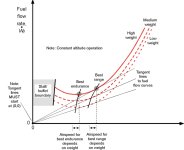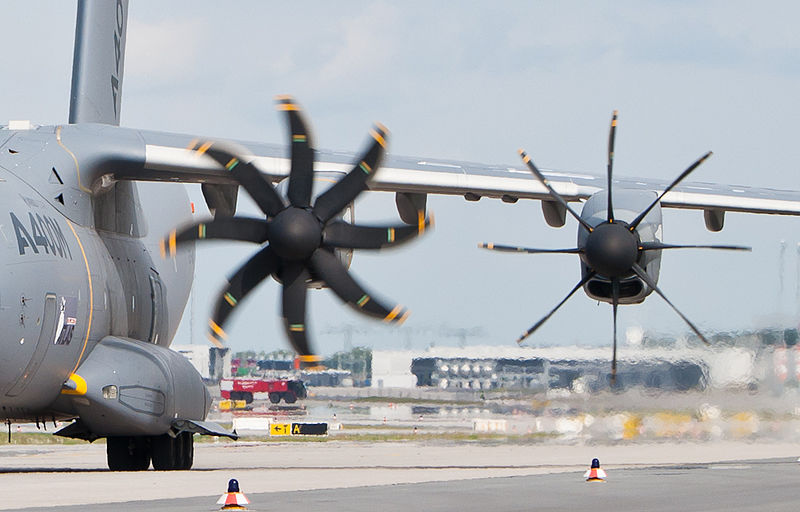[...]
The designer, Burt Rutan was explicit against CSP on the LongEz mainly because the dirty flow after the fuselage and weight and balance. Anyway I would use a CSP if would be a serious advantage over one speed.
[...]
Back to the topic. What I would know really is about advantages of a CSP if you keep the same IAS but you are turning your engine lower due to lower weight.
Thanks,
Filipe
I spent some time outside of work playing with this because I happen to have a (not flying) LongEZ project, and so happen to have a lot of information at hand for it, and have spent some thing thinking about different powerplant options. So what follows is a personal rather than professional effort; I did this for fun and it turned out pretty long...
First, a minor disagreement: the dirty flow from a pusher is a problem for the propeller, regardless of whether it's a fixed pitch or a constant speed. However, the weight and balance is a serious consideration for the LongEZ, and I wouldn't even think about using a constant speed prop on mine without putting in a much lighter engine. Rutan was against putting CS props (and starters and other "unnecessary" equipment) on EZs, but he put two on the Voyager for which the entire mission was maximizing range. A lot of the larger UAVs use constant speed props as well, even though they spend most of their time at a specific loiter condition. As the aircraft gets bigger, the additional weight of the constant speed prop is a smaller percentage of the total and therefore becomes more palatable. And it's much easier to justify if the weight of the CS system is included in the original design because it won't compromise the finished aircraft as much as adding it as an afterthought.
Second, there are going to be a fair number of assumptions here and this is analytical, rather than based on measured data. So my real answer is my favorite one: it depends. Namely, it depends on how far off condition you end up, and for how long. I played with conditions a little so we could get a sense of how much. This is not an exhaustive analysis, more an quick exploration of some edge cases and is intended to be illustrative rather than exact.
Third, here goes: We've got a LongEZ with an O-235, that performs like the flight manual says it does, and we're going to set up on the condition shown for best range in the manual: 40% Power, 12,500 ft, 127 KTAS. We're going to be at such low powers that we're almost always going to be at partial throttle rather than wide open, and I don't know how much you can drag the RPM around with LOP ops on a carbed engine like this, so I'm going to ignore that. I take my fixed pitch that's set up for 75% cruise and run it at the partial throttle setting for this best range condition, and see how much thrust we make: this with the aircraft parameters lets me calculate the lift and drag in this condition. I'll use the aircraft parameters to further determine both induced and parasitic drag; I'll hold the parasitic drag coefficient constant and vary the induced drag based on the weight and speed.
Now, we want to optimize for this condition; so I'm going to set up my fixed pitch prop to be at the bottom of the specific fuel consumption curve for this particular engine (2200 RPM) with the aero design close to ideal efficiency at this condition. If we could guarantee we'd stay in this condition, we wouldn't want to do this because we'll get lighter over time so we'd want to set it up to minimize the area under the fuel consumption curve over the entire flight and start at a higher RPM. This is where engine details and how much the ignored LOP influences things are really going to matter, the shape (which is not necessarily symmetric) and location of the minimum specific fuel consumption bucket varies with engine model. The bucket I'm using for the 235 is really shallow and therefore more tolerant of RPM excursions than other engines are; it's also not symmetric and this will be illustrated by the scenarios I've set up.
I'm also going to run a similar CS blade, and it will always run at the RPM for minimum specific fuel consumption. I'll calculate the power required for each propeller and that will go into the fuel burn calculation. Across the subject conditions, the operating efficiency of the blades is pretty close.
I'll use 1425 lbf to represent the performance at the beginning of the flight, and 1200 lbf to represent performance near the end of the flight; this is ~37 gal so you've got ~13 gal minus some reserve left to fly. I'm going to vary the speed to keep the aircraft at the same L/D, and then recalculate the drag and therefore thrust required from each prop. So this isn't a constant airspeed, the indicated speed to fly varies with weight.
Scenario 1a: You luck out, and can stay at 12,500 the whole flight. At the beginning, the performance is the same and the fuel burn is the same. At the end, the FP is down to 2020 RPM and the CS fuel burn is 0.07 gal per hour better. So, spread out across the entire flight the CS saves ~0.4 gallons and buys an extra ~9 minutes of endurance and ~15 miles of range. Differences here are insignificant and in practice will depend on details not captured.
Scenario 1b: Same as 1a, but as a check on my assumption that airframe efficiency, and therefore power required, is a more significant factor than prop efficiency deltas, fly a constant indicated airspeed the whole time. This keeps the FP close to the bottom of the bucket the whole time, only reducing by 45 RPM, so the fuel burn difference between the FP and CS is even smaller. But, flying like this requires more power and therefore reduces the range by ~39 nm between the two weights for the FP, and you're burning an extra 0.45 GPH at the end condition.
Scenario 2: The winds up high are awesome, so you climb to 20,000 feet for the flight to take advantage of them. I'm going to change the starting weight to 1375 lbf to swag the fuel for climb, and we're not going to address differences in climb performance and how long each one takes to get there because we're talking about staying at one condition. We've got to turn the FP up to ~2430 RPM to stay on speed, but the CS is still at 2200 RPM. Both are pretty close to WOT here because the engine's out of breath. On average, the CS is burning 0.04 GPH less, so it only saves ~0.3 gal and buys ~6 min of endurance. This could be more significant if the engine fuel curve wasn't as tolerant of higher RPMs. This could also be more significant if you could spend more time here and therefore drift on speed and RPM further, but with the assumed fuel quantity and the fuel to climb, you've got less fuel and time spent in this condition so the differences here are insignificant and in practice will depend on details not captured here.
Scenario 3: The weather is terrible, so you're stuck at 5,000 ft for the whole flight. You've got to drag the FP down to ~1940 RPM to start with and down to ~1800 RPM by the end. The CS saves ~0.16 GPH for this set up, and so saves ~1.9 gallons and buys an additional ~42 minutes of endurance or ~70 miles of range. A small but not an insignificant difference, this is ~5.5% increase in range for this scenario.
Also implicit is the ability to precisely control fuel, imprecise leaning is easily a far larger margin of error than the analytic differences shown here. The difference between scenario 2 and 3 illustrates the asymmetric nature of the 235 fuel burn curve I used: higher RPMs increase the relative fuel burn less than lower RPMs do and so increases in altitude are less problematic than decreases. This could be adjusted to prioritize performance at lower altitudes by biasing the design to higher RPMs to start, at the expense of performance at higher altitudes, and eventually blade efficiency as well; this is, in general, a worse set up and I wouldn't try to do a max range flight on a day where I'm stuck at 5kft. But circumstances could force you there when you weren't planning on it and this is illustrated by the scenario as an extreme; the real impact would be less depending on how long into your flight you were forced lower.
Now, getting back to my original point: it depends. For 2/3 of these specific scenarios and exercises, the CS prop doesn't seem to save much and you'd try not to put yourself in that third one, but it depends on a custom fixed pitch design and getting it set up well for the conditions of the day while the CS prop adapts to any condition. This also depends on the quality of the designs; both the props I've used are well designed and therefore similar; if the quality of the designs was asymmetric so too would be the results. Further, this specific mission is at very low powers, so changes in propeller efficiency are therefore small absolute changes in power and fuel flow; applications and/or missions with more power or engines with less forgiving fuel burn curves would be more influenced by differences in aerodynamic efficiency. Change those factors, and the answer could change as well.
So, in summary, if I wanted to maximize only the range of a LongEZ with a 235 I'd personally stick with a fixed pitch prop and look for gains elsewhere (starting with fairings and cooling drag). However, if I was going to design the next generation of LongEZ with the goal of total performance (TotallyEZ?), I'd lay out the aircraft to accept a constant speed prop and a more powerful engine.






